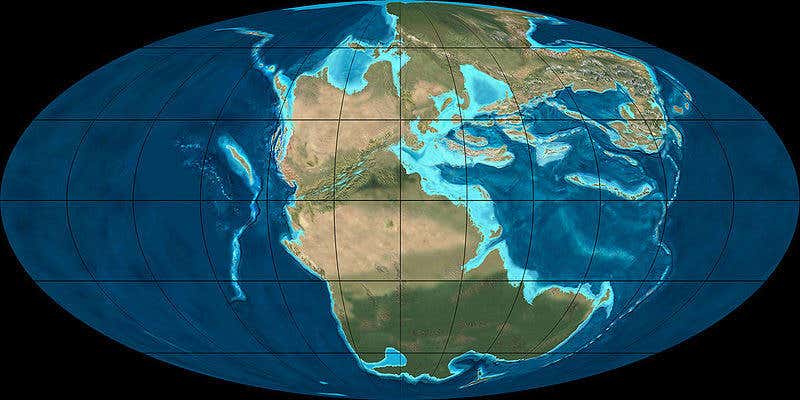Severe land-sea events 100 million years ago triggered mass extinctions
Interaction between land and sea millions of years ago led to devastating marine life extinctions and altered the path of evolution on Earth

A global reconstruction of the Earth during the Late Triassic, approximately 220 Million years ago, showing Gondwana breaking away from Laurasia in the north and the formation of the Iapetus Ocean. (CREDIT: CC BY-SA 3.0)
Scientists have uncovered how a "tag-team" interaction between oceans and continents millions of years ago led to devastating marine life extinctions and altered the path of evolution on Earth.
This new understanding sheds light on a series of severe environmental crises, known as oceanic anoxic events, which occurred between 185 and 85 million years ago. These crises were marked by critically low levels of dissolved oxygen in the seas, leading to significant biological upheavals, including mass marine extinctions.
The study, led by the University of Southampton and published in Nature Geoscience, brings a fresh perspective on the geological forces responsible for these events.
Professor Tom Gernon, a leading author of the study and an Earth Science professor at Southampton, described these oceanic anoxic events as akin to "hitting the reset button" on the planet's ecosystems. The real challenge, he explained, was identifying which geological processes triggered this reset.
In collaboration with academics from institutions including the universities of Leeds, Bristol, Adelaide, Utrecht, Waterloo, and Yale, the researchers focused on the impact of plate tectonics on ocean chemistry during the Mesozoic era. This era, spanning the Jurassic and Cretaceous periods, is famously known as the age of dinosaurs. In the UK, this period is prominently exposed along the Jurassic Coast and the cliffs of Whitby and Eastbourne.
To understand the link between tectonic activity and oceanic crises, the team utilized statistical analyses and advanced computer models. Their research delved into how chemical cycles in the ocean responded to the breakup of the supercontinent Gondwana, a landmass once inhabited by dinosaurs.
According to Professor Gernon, this breakup led to intense volcanic activity around the world, which, in turn, played a crucial role in these events.
Related Stories
As tectonic plates shifted and new seafloors formed, large quantities of phosphorus, an essential nutrient for life, were released from weathering volcanic rocks into the oceans. The researchers discovered multiple pulses of chemical weathering on both the seafloor and continents. These pulses alternately disrupted ocean chemistry, creating a "geological tag-team" effect, as described by Professor Gernon.
The timing of these weathering pulses coincided with most oceanic anoxic events recorded in rock formations. The influx of phosphorus into the ocean acted as a natural fertilizer, boosting the growth of marine organisms. However, this growth came at a significant cost to marine ecosystems.
As biological activity surged, vast amounts of organic matter sank to the ocean floor, consuming large quantities of oxygen. This process led to the creation of anoxic "dead zones" where most marine life perished.
Professor Benjamin Mills, a co-author from the University of Leeds, explained that these anoxic events typically lasted between one to two million years and had profound impacts on marine ecosystems. The effects of these events are still felt today, as the rocks rich in organic matter that accumulated during this period are now the largest source of commercial oil and gas reserves globally.
Beyond explaining the cause of extreme biological turmoil during the Mesozoic era, this study also highlights the devastating effects of nutrient overloading on modern marine environments. The researchers drew parallels between these ancient events and current human activities, which have reduced mean oceanic oxygen levels by about two percent, leading to a significant expansion of anoxic water masses.
Professor Gernon emphasized the importance of studying geological events to gain insights into how the Earth might respond to future climatic and environmental stresses. The team's findings reveal a stronger-than-expected connection between the Earth's interior and its surface environment, especially during periods of tectonic and climatic upheaval.
The study underscores the profound impact that geological events, such as the breakup of continents, can have on the surface environment and the course of evolution. Professor Gernon remarked on the remarkable chain of events within the Earth that can lead to devastating surface effects, noting how the tearing apart of continents has left a lasting mark on the planet's history and continues to shape its future.
Note: Materials provided above by The Brighter Side of News. Content may be edited for style and length.
Like these kind of feel good stories? Get The Brighter Side of News' newsletter.
Rebecca Shavit
Science & Technology Journalist | Innovation Storyteller
Based in Los Angeles, Rebecca Shavit is a dedicated science and technology journalist who writes for The Brighter Side of News, an online publication committed to highlighting positive and transformative stories from around the world. With a passion for uncovering groundbreaking discoveries and innovations, she brings to light the scientific advancements shaping a better future. Her reporting spans a wide range of topics, from cutting-edge medical breakthroughs and artificial intelligence to green technology and space exploration. With a keen ability to translate complex concepts into engaging and accessible stories, she makes science and innovation relatable to a broad audience.



